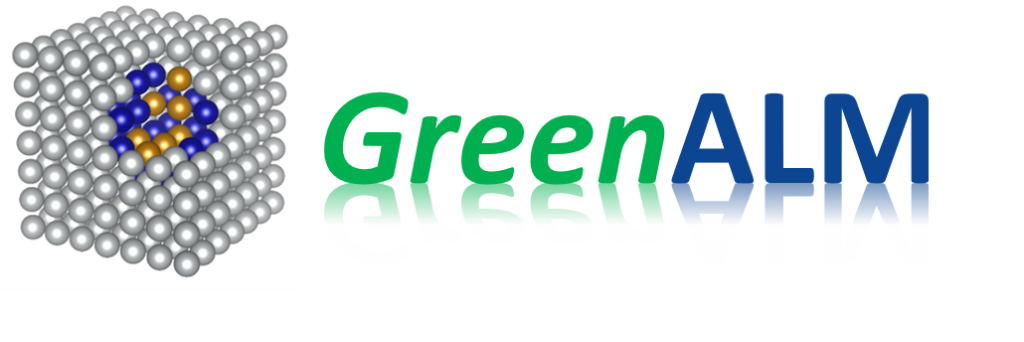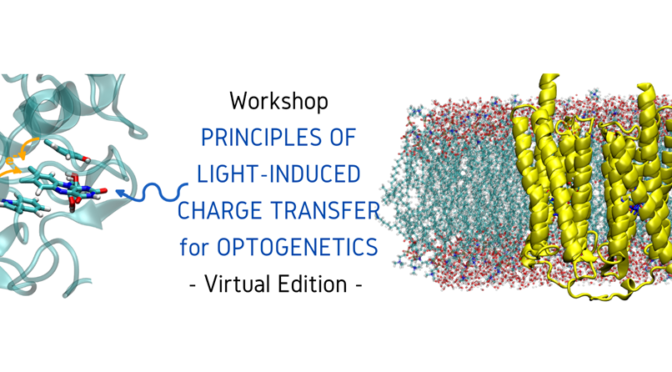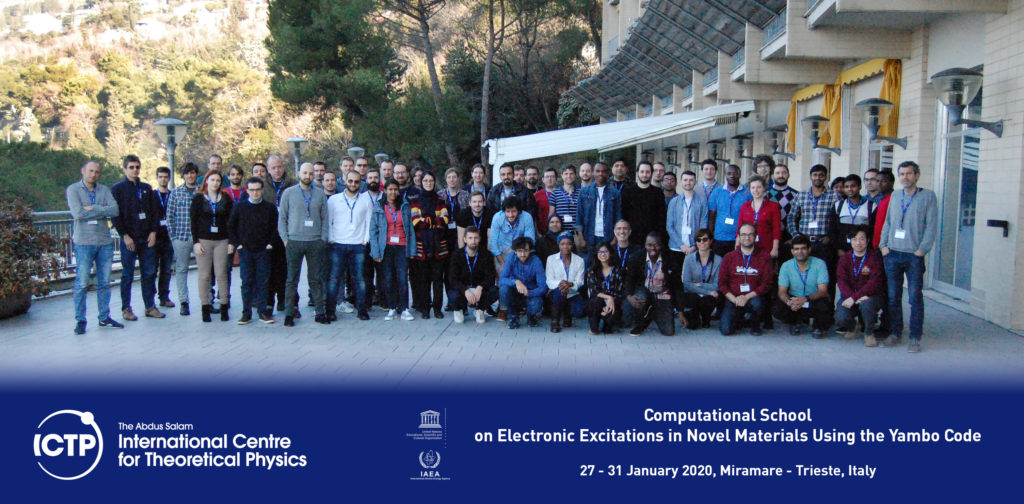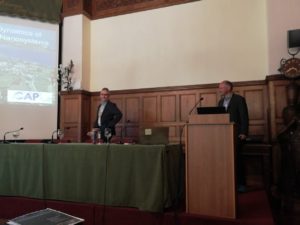
 The virtual Psi-k GreenALM Hands-on Tutorial 2021 took place from Oct. 11-14, 2021 in virtual form (https://greenalmtutorial.mcl.at/). It was organized by the Materials Center Leoben Forschung GmbH (www.mcl.at) together with the team from the Vienna Scientific Cluster and Co-organizers from KTH Stockholm and Montanuniversität Leoben and was additionally funded by Psi-k and EuroCC Austria. Continue reading Report on the Virtual Psi-k GreenALM Hands-on Tutorial 2021
The virtual Psi-k GreenALM Hands-on Tutorial 2021 took place from Oct. 11-14, 2021 in virtual form (https://greenalmtutorial.mcl.at/). It was organized by the Materials Center Leoben Forschung GmbH (www.mcl.at) together with the team from the Vienna Scientific Cluster and Co-organizers from KTH Stockholm and Montanuniversität Leoben and was additionally funded by Psi-k and EuroCC Austria. Continue reading Report on the Virtual Psi-k GreenALM Hands-on Tutorial 2021
Category Archives: Reports
Recent developments in quantum Monte Carlo

Location: Rome, Italy |
With advances in algorithms and growing computing power, quantum Monte Carlo (QMC) methods have become a powerful tool for the description of a variety of quantum fluids and a viable alternative for high-accuracy calculations of the electronic structure of many atoms, molecules and solids. They are, however, at a less mature stage than today’s ready-for-use quantum-chemistry or density-functional packages: while the production of results on a variety of quantum many-body systems has been going on for at least three decades, a significant effort is still devoted to research and development of methods and algorithms, including real-time dynamics, super-accurate optimization strategies for trial wavefunctions and molecular structures, inputs for the density functional theory of van der Waals forces, and eventually neural networks which at least for small molecular systems seem to improve the accuracy of variational quantum Monte Carlo to the point where it outperforms other ab-initio quantum chemistry methods.
PRINCIPLES OF LIGHT-INDUCED CHARGE TRANSFER FOR OPTOGENETICS
Principles of light-induced charge transfer for optogenetics
14-16 June 2021, online
The “Principles of light-induced charge transfer for optogenetics” workshop was held online from June 14 to June 16, 2021.
The workshop was attended by 81 participants The total number of participants is 81 coming from 16 countries, as specified: Italy: 42; United States of America: 8; Germany: 7; India: 6; United Kingdom: 3; Poland: 3; Netherlands: 2; Austria: 2; Hungary: 1; Czech Republic: 1; Cameroon: 1; China: 1; Belgium: 1; France: 1; Israel: 1; Egypt: 1.
14 participants were invited speakers, 17 were contributing speakers, 3 were members of the CT4OPTO scientific committee, and 3 of the organizing committee. The event was organized by the Institute Nanoscience of the National Research Council of Italy, the University of L’Aquila and the University of Southern California. The event was sponsored by Psi-k, received the patronage of Cecam-IT-Simul, and was supported by Gruppo Alchimie for technical assistance. Continue reading PRINCIPLES OF LIGHT-INDUCED CHARGE TRANSFER FOR OPTOGENETICS
Integration of ESL modules into electronic-structure codes
The workshop Integration of ESL modules into electronic-structure codes was held in Lausanne February 17 2020 to February 28 2020. It was joined by 21 participants from a large fraction of the electronic structure codes. We had an initial 2 day discussion round followed by coding sessions for 10 days. Discussions were focused on how ESL should proceed in the future and we invite all to join our monthly meetings for a chat, contact us at esl <at> cecam.org for more information.
Sponsors: CECAM and Psi-K
The workshop was a continuation of a series of workshops in the ESL spirit, see here focused on integrating currently available ESL libraries into existing electronic structure codes.
Some of the goals achieved were:
- Integration of Psolver into Octopus and SIESTA
- Improving ESL bundle usability and maintainability. Patches for packages part of the ESL bundle improved the bundles capacity to build more easily.
- Several bugs found in packages were reported up stream which will eventually go down to the bundle packages (temporary patches are distributed with the ESL bundle).
- Ensured OMM package has an official release.
- ELSI-RCI was fully integrated into DFTB+
- FHI-AIMS integration with LibXC was greatly improved and MGGA can now be used.
- Preparation of two more ESL bundle packages, abinit-common and libPAW
- Expand the collaborations of the ESL towards more DFT codes and methodologies
Workshop details, such as the program, participant list and organizers may be found here. The final report will be made available here (not currently available, but will be once a follow-up meeting has finished).
The story of Psi-k: From CCP9 to Psi-k
Click here to read a brief, personal and unofficial account of the first 25 years of the Psi-k Network, written by members of the Band Theory Group at STFC Daresbury Laboratory. This is a record of the authors own recollections, particularly of events in the early days, and of the subsequent evolution of the Network as the scientific field itself evolved technically and intellectually. It is important to note that this is a record of how the authors saw things; it is in no way intended to be an “authorized history” of Psi-k.
Computational School on Electronic Excitations in Novel Materials Using the Yambo Code
From 27th to 31th January 2020 the YAMBO school devoted to first-principles calculations of electronic excited state properties in Novel Materials was held at the Abdus Salam International Center for Theoretical Physics on the Miramare seafront in Trieste. This school welcomed 56 participants from 22 countries, and 18 staff members among lecturers, teaching assistants, and organizers. The event was sponsored jointly by the Max Centre of Excellence Materials at Exascale, ICTP, and Psi-k network. The participants were 65% Master or PhD students and 35% postdocs. Overall participated 75% males and 25% females.
The goal of the school was to provide training on theoretical and computational methods to study the exciting properties with a particular focus on Novel Materials of interest for optoelectronics. In the morning, the students followed lectures on the fundamentals, from Density Functional Theory to linear response and many-body perturbation theory. A completely new session has been dedicated to real-time MBPT methods and simulations which are able to tackle electronic correlation beyond linear response.
The theoretical lectures were followed by technical ones on the implementation, within first principles, of the main theoretical equations, with a special focus on the Yambo code. Continue reading Computational School on Electronic Excitations in Novel Materials Using the Yambo Code
Hermes 2018 Summer School in Computational Materials Science and Scientific Communication
Introduction
Hermes 2018 Summer school began with an inspiring introductory lecture from keynote speaker Prof. Adrian Sutton, sharing with us his exciting story of his academic work and personal journey in condensed matter physics and materials science. Prof. Sutton is a fellow of the Royal Society and one of the founders of the Thomas Young Centre for the theory and simulation of materials in London.
Prof. Sutton’s talk discussed the importance of recent developments in materials science and the potential impact of future technological materials on human life. For example, he discussed polymer/plastic technologies, how important plastics have become in our everyday lives, as well as the impact of these technologies on the environment and how we can make a difference as theoretical/computational scientists.
Following the keynote lecture, informal discussions continued over dinner in the beautiful dining halls of the Cumberland Lodge. The evening ended with an informal ice-breaking social mingle, allowing the participants to relax, explore the great Windsor Park and the lodge itself while getting to know each other.
A demanding several days awaited: a series of graduate lectures focusing on the main branches of computational materials science, a series of workshops on those topics (molecular dynamics, density functional theory and finite element modeling), and a seriesof lectures and workshops on science communication, to be put to use in the poster session and presentation competition. Continue reading Hermes 2018 Summer School in Computational Materials Science and Scientific Communication
PSI-K/CECAM Workshop on Ultrafast Physics from Molecules to Nanostructures
Joint Psi-K / CECAM workshop: Ultrafast Physics from Molecules to Nanostructures
Dates: 7-10. October 2019
Location: San Sebastian, Spain
The impressive progress in ultrafast laser technology, ranging from the femtosecond to the attosecond timescale and from the THz to the XUV frequency range, is making possible to probe real-time electronic and nuclear dynamics in atoms, molecules and solids. Fundamental insight can be gained into the primary photoinduced processes in systems with growing level of complexity. The capability of following and steering ultrafast dynamics has tremendous impact in a wide range of applications, from materials science to life sciences.
Clearly, advances in theories and methods inevitably require an intense exchange with the experimental community due to the complexity of the systems and of the measurements. In the last decade the effort in developing predictive and computationally feasible methods has virtually exploded. Ab initio approaches based DFT and nonequilibrium Green’s function (NEGF) have recently made contact with time-resolved experiments in 2D systems and nanostructures. Other ab initio methods based on wavefunctions (e.g., ADCn, CASPTn) or reduced quantities (e.g., TDDFT, NEGF) are opening up high prospects to access the electron-nuclear subfemtosecond dynamics in molecules. Furthermore, accurate real-time numerical methods have been put forward for strongly correlated model systems (e.g., TD- DMFT and DMRG).
The workshop has gathered world-leading experimental, theoretical and computational experts working in the field of electronic and nuclear dynamics in atoms, molecules and solids. These four days have provided a unique cross- fertilization opportunity to advance the current ab-initio state-of-the-art approaches. Several key and crucial questions have been vividly and intensely debated: how to extend the accuracy of ab-initio methods out-of-equilibrium? How to efficiently benefit from the advances in computation facilities to simulate the nonequilibrium dynamics of large molecules, nanostructures and solids? How to translate laser-pulse features (pulse center frequency, bandwidth, duration, fluence, polarization) into boundary conditions and suitable approximations for the computational tools? Can we devise a series of tools and procedures to provide to the community? We have also confronted different theoretical formulations of experimental outcomes, discuss their range of applicability as well as their physical and numerical limitations. For the various approaches we have explored how to include the missing physics and whether this inclusion is numerically feasible.
Organisers:
Giulio Cerullo (PM, Milano)
Hardy Gross (MPI, Halle)
Andrea Marini (CNR, Rome)
Mauro Nisoli (PM, Milano)
Angel Rubio (MPI, Hamburg)
Gianluca Stefanucci (UTV, Rome)
Big Data Summer: A summer school of the BiGmax Network
Platja d’Aro, Spain, September 9 – 13, 2019
Webpage: https://th.fhi-berlin.mpg.de/meetings//BiGmax-Summer-2019/
Organizers:
Gerhard Dehm
Max-Planck-Institut für Eisenforschung, Düsseldorf, Germany
Claudia Draxl
Humboldt-Universität zu Berlin, Berlin, Germany
Matthias Scheffler
Fritz Haber Institute of the Max Planck Society, Berlin, Germany
Jilles Vreeken
CISPA – Helmholtz Center for Information Security, Germany
Scope:
Materials science is entering an era where the growth of data from experiments and simulations is expanding beyond a level that is addressable by established scientific methods. The so-called “4 V challenge” – concerning Volume (the amount of data), Variety (the heterogeneity of form and meaning of data), Velocity (the rate at which data may change or new data arrive), and Veracity (uncertainty of quality) is clearly becoming eminent. Issues are, for example, an early discrimination between valuable and irrelevant experimental data, understanding errors in both experiment and theory, and assigning error bars and trust levels to density-functional theory high-throughput screening results, just to name a few. Most importantly, however, is that Big Data of materials science provide a significant chance for new insight and knowledge gain when fully exploiting its information by artificial intelligence concepts and methods. All the above aspects – from data processing to exploiting the potentials of data-driven materials science – require new and dedicated approaches.
Continue reading Big Data Summer: A summer school of the BiGmax Network
REPORT: MSSC2019 – AB INITIO MODELLING IN SOLID STATE CHEMISTRY
The Department of Chemistry and the Thomas Young Centre at Imperial College London and the Theoretical Chemistry Group of the University of Torino, in collaboration with the Computational
Materials Science Group of the Science and Technology Facilities Council (STFC), organized the 2019 MSSC Summer School on the “ab initio modelling of crystalline and defective solids with the CRYSTAL code”.
CRYSTAL is a general-purpose program for the study of periodic solids. It uses a local basis set comprised of Gaussian type functions and can be used to perform calculations at the Hartree-Fock, density functional or global and range-separated hybrid functionals (e.g. B3LYP, HSE06), double hybrid levels of theory. Analytical first derivatives with respect to the nuclear coordinates and cell parameters and analytical derivatives, up to fourth order, with respect to an applied electric field (CPHF/CPKS) are available.
The school provided an overview of the underlying theory and fundamental issues affecting use of the code, with particular emphasis on practical issues in obtaining reliable data efficiently using modern computer hardware.
All information about the school can be found on this website:
http://www.imperial.ac.uk/mssc2019/
Read the full workshop report here: MSSC2019_Psi-k_report



